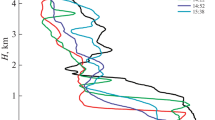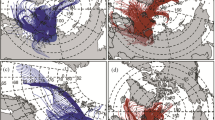Abstract
Major processes of generation of the methane field in the atmosphere over northwestern Russia have been studied on the basis of measured surface concentration and total content of methane in the environs of St. Petersburg, air-mass trajectories, and a three-dimensional regional pollution transport model. It is shown that the contribution of methane emission from an industrial center to the total column amount of methane is no more than 2% of its average value. At the same time, because of this emission, the surface methane concentration in the environs of St. Petersburg varies by as much as 50%. The origin of air masses arriving at the site of measurements influences both the total content and the surface concentration of methane. The air masses that passed over the continental part of western and eastern Europe are characterized by the values of total content and surface concentration of methane that are about 4% higher than those in the air masses formed over the ocean, which come to the region from the northwest. The regional transport model for greenhouse gases satisfactorily describes the results of surface measurements and adequately simulates observed tendencies in the change of total methane content. An estimate of the integral emission of methane into the atmosphere from St. Petersburg and its industrial suburbs is about 100 kt per year.
Similar content being viewed by others
References
S. V. Yagovkina, I. L. Karol’, V. A. Zubov, et al., “Evaluation of Methane Fluxes into the Atmosphere from the Gas Fields of the North of Western Siberia with a Three-Dimensional Regional Transport Model,” Meteorol. Gidrol., No. 4, 49–62 (2003).
M. V. Makarova, A. V. Poberovskii, and Yu. M. Timofeev, “Spectroscopic Measurements of the Total Methane Content in the Atmosphere over St. Petersburg,” Izv. Akad. Nauk, Fiz. Atmos. Okeana 37, 67–73 (2001) [Izv., Atmos. Ocean. Phys. 37, 61–66 (2001)].
N. N. Paramonova, V. I. Privalov, and A. I. Reshetnikov, “Carbon Dioxide and Methane Monitoring in Russia,” Izv. Akad. Nauk, Fiz. Atmos. Okeana 37, 38–43 (2001) [Izv., Atmos. Ocean. Phys. 37, 34–39 (2001)].
G. N. Smetanin, V. I. Privalov, A. I. Reshetnikov, and N. I. Paramonova, “Gasochromatic Setup for Precision Measurements of Methane Concentration in the Atmosphere against the Background Level,” Tr. Filiala GGO Nauchno-Issled. Tsentra Distant. Zondir. Atmos., Prikladn. Meteorol., No. 2 (2000).
R. R. Draxler and G. D. Rolph, HYSPLIT (HYbrid Single-Particle Lagrangian Integrated Trajectory) Model Access via NOAA ARL READY Website (http://www.arl.noaa.gov/ready/hysplit4.html), NOAA Air Resources Laboratory, Silver Spring, MD, 2003.
F. V. Kashin, V. N. Aref’ev, Yu. I. Baranov, et al., “Variability of the Methane Content in the Atmospheric Surface Layer and in the Atmospheric Column,” Izv. Akad. Nauk, Fiz. Atmos. Okeana 40, 403–409 (2004) [Izv., Atmos. Ocean. Phys. 40, 356–361 (2004)].
M. Buchwitz, R. de Beek, S. Hoel, J. P. Burrows, et al., “Carbon Monoxide, Methane and Carbon Dioxide Columns Retrieved from SCIAMACHY by WFM-DOAS: Year 2003 I Initial Data Set,” Atmos. Chemi. Phys. Discuss. 5, 1943–1971 (2005).
Climatic Characteristics of Conditions for Pollutant Spread in the Atmosphere, Handbook, Ed. by E.Yu Bezuglaya and M. E. Berlyand (Gidrometeoizdat, Leningrad, 1983) [in Russian].
A. V. Zinchenko, N. N. Paramonova, V. I. Privalov, and A. I. Reshetnikov, “Estimation of Methane Emissions in the St. Petersburg, Russia, Region: An Atmospheric Nocturnal Boundary Layer Budget Approach,” J. Geophys. Res. 107, 4416, doi:10.1029/2001JD001369 (2002).
A. V. Zinchenko, N. N. Paramonova, V. I. Privalov, and A. I. Reshetnikov, “Evaluating the Emission of Methane over St. Petersburg from Measurements of Its Concentration in the Atmospheric Surface Layer,” Meteorol. Gidrol., No. 5, 35–49 (2001).
N. N. Paramonova, V. I. Privalov, and A. I. Reshetnikov, “Measurements of the Concentrations of Carbon Dioxide and Methane at the Russian Background Stations,” in Review on the Environmental Pollution in the Russian Federation over 2003 (Gidrometeoizdat, St. Petersburg, 2004), pp. 123–129 [in Russian].
“Global Atmosphere Watch. World Data Center for Greenhouse Gases,” No. 9 (2003), http://gaw.kishow.go.jp/wdcgg.html.
D. Lowry, E. G. Nisbet, N. D. Rata, and C. W. Holmes, Isotopic Analysis of Air at Royal Holloway. Development and Testing of an Advanced Approach to Quantitative Estimation of Russian Methane Emissions (INTAS-RFBR 95-0696, Final Report, St. Petersburg, 1999), pp. 62–70.
www.cmdl.noaa.gov/ccgg/resources/sw/ccgvu.
F. V. Kashin, N. E. Kamenogradskii, E. I. Grechko, et al., “Comparisons of Different Methods of Ground-Based Spectroscopic Measurements of the Total Methane Content in the Atmosphere,” Izv. Akad. Nauk, Fiz. Atmos. Okeana 37, 339–345 (2001) [Izv., Atmos. Ocean. Phys. 37, 314–319 (2001)].
J. Notholt, G. Toon, F. Stordal, et al., “Seasonal Variations of Atmospheric Trace Gases in the High Arctic at 79° N,” J. Geophys. Res. D 102, 12855–12861 (1997).
M. Nilsson, C. Mikkela, I. Sundh, et al., “Methane Emission from Swedish Mires: National and Regional Budgets and Dependence on Mire Vegetation,” J. Geophys. Res. D 106, 20847–20860 (2001).
K. J. Hargreaves, D. Fowler, C. E. R. Pitcairn, and M. Aurela, “Annual Methane Emission from Finnish Mires Estimated from Eddy Covariance Campaign Measurements,” Theor. Appl. Climatol. 70, 203–213 (2001).
T. R. Christensen, A. Ekberg, L. Strom, et al., “Factors Controlling Large Scale Variations in Methane Emissions from Wetlands,” Geophys. Rev. Lett. 30, 671–674 (2003).
Y. Tohjima, S. Wakita, S. Maksyutov, et al., “Distribution of Tropospheric Methane over Siberia in July 1993,” J. Geophys. Res. D 102, 25371–25382 (1993).
T. A. Egorova, E. V. Rozanov, V. A. Zubov, and I. L. Karol’, “Model for Investigating Ozone Trends (MEZON),” Izv. Akad. Nauk, Fiz. Atmos. Okeana 39, 310–336 (2003) [Izv., Atmos. Ocean. Phys. 39, 277–292 (2003)].
P. K. Patra, S. Lal, S. Venkataramani, and D. Chand, “Halogen Occultation Experiment (HALOE) and Balloon-Borne in situ Measurements of Methane in Stratosphere and Their Relation to the Quasi-Biennial Oscillation (QBO),” Atmos. Chem. Phys. 3, 1051–1062 (2003). www.atmos-chem-phys.org/acp/3/1051/.
Author information
Authors and Affiliations
Additional information
Original Russian Text © M.V. Makarova, A.V. Poberovskii, S.V. Yagovkina, I.L. Karol’, V.E. Lagun, N.N. Paramonova, A.I. Reshetnikov, V.I. Privalov, 2006, published in Izvestiya AN. Fizika Atmosfery i Okeana, 2006, Vol. 42, No. 2, pp. 237–249.
Rights and permissions
About this article
Cite this article
Makarova, M.V., Poberovskii, A.V., Yagovkina, S.V. et al. Study of the formation of the methane field in the atmosphere over northwestern Russia. Izv. Atmos. Ocean. Phys. 42, 215–227 (2006). https://doi.org/10.1134/S0001433806020083
Received:
Accepted:
Issue Date:
DOI: https://doi.org/10.1134/S0001433806020083




